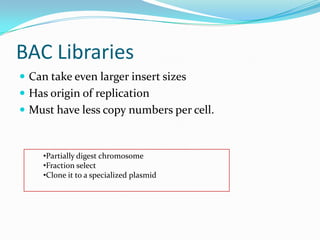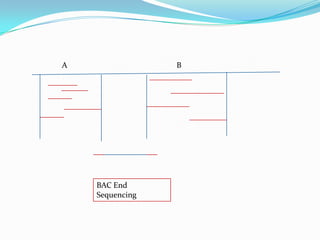Lecture 1,2
- 1. Genomics
- 2. Topics to be covered • Introduction. • History of Genome Sequencing. • How genomes are sequenced. • Packaging • Transfection • Recovery of clones • Strategies of genome sequencing • Application of genome sequencing.
- 3. Period of time between first man-powered flight and landing on the moon (1902-1969): 67 years Period of time between discovery of structure of DNA and determination of the sequence of the entire human genome (1953-2010?) 57 years (?)
- 4. What is a Genome? • Gene + Chromosome -> Genome A/T/G/C A/U/G/C
- 5. Why determine the order of nucleotides? • Determining the order of billions of chemical units that builds the genetic material. – Secrets of life is locked up in the order of the 4 letters!!!! 5-100 million living species???
- 6. Genome Sequencing History Organism Year Institute Genome Size Bacteriophage 1976 Walter Fiers at 3569 bp MS2 the University of Ghent Phage Φ-X174 1977 Fred Sanger 5386 bp Cambridge Haemophilus 1995 TIGR 1,830,138 bp influenzae Saccharomyces 1996 European Effort 12,495,682 cerevisiae (16 chromosomes) Human Genome 2000 Multiple 3.3 x 109 Project Organizations (3 billion letters)
- 7. Genomes Sequenced so far… 19987 – 19718 (26th Sept 2012) • Eukaryotes [2231] – Animal – Fungi – Plants – Protists – Others • Prokaryotes [14268] • Viruses [3219] Ref: http://www.ncbi.nlm.nih.gov/genome/browse/
- 8. Genomic Libraries DNA Extraction and Restriction Cell Purification Digestion Size Blunt End End sealing 3 KB Selection
- 9. Types of Libraries Genomic Libraries Plasmids (2-10 KB) Bacteriophage (9-23 kb) Cosmid libraries (30 – 40 kb) BAC libraries (125 – 200 kb) YAC libraries
- 10. Restriction Enzymes 4 cutters 6 cutters 8 cutters ¼ * ¼ * ¼ * ¼ = 1/256; 1/4096; 1/65536 Small Problem: Human genome size: 3 billion base pairs How many fragments can be generated using a 4 cutter, 6 cutter and 8 cutter? 16 million for 4 cutters 1*10^6 = 1 million for 6 cutters 1/16 million for 8 cutters
- 11. Blue Glucuronides Genomic Libraries B-Glucuronidase Antibiotics Resistant Genes One in thousand plasmid Enzymes will get foreign DNA DNA to be cloned Electroporate
- 12. The exact probability of having any given DNA sequence in the library can be calculated from the equation N = ln(1 -P)/ln(1 - f) P is the desired probability f is the fractional proportion of the genome in a single recombinant [Ex. For 4 cutter for human genome would be 256 * 3 X 10^9] N is the necessary number of recombinants For example, how large a library (i.e. how many clones) would you need in order to have a 99% probability of finding a desired sequence represented in a library created by digestion with a 6-cutter? N = ln(1 - 0.99)/ln(1 - (4096/3x109)) N = 3.37 x 106 clones
- 13. Bacteriophage libraries Insert size is larger -> Number of clones needed is smaller Lytic and Lysogenic Head, tail Recombinant DNA Assembly Protein Cos site (200 bp long, nicked 12 bp overhang : terminase) Organism Genome size is 50 KB Critical KB is required for Packaging Vectors are of size 25KB Upto 25 KB external DNA can be added
- 14. Step - 1 Large Number of Empty heads and tails Infect Bacteria with Mutant phage •Lacking critical size •Lacking Assembly protein Extract Empty Head and Tails
- 15. Step - 2
- 16. Step -3 Add Packaging enzyme Mix Empty heads + Packaged viral tails + Recombinant Particles DNA Transparent plaques: Made to Infect Each one contains a Bacterial cells fragment multiplied Grow infected and non-infected cells Transfection
- 17. Cosmid Libraries Takes larger insert sizes Can grow in bacteria or any other host Needs an origin of replication SV40 ori can grow in mammals ColE1 in E.coli
- 18. BAC Libraries Can take even larger insert sizes Has origin of replication Must have less copy numbers per cell. •Partially digest chromosome •Fraction select •Clone it to a specialized plasmid
- 19. Various uses of BAC libraries Physical mapping of genes Cloning of valuable genes Chromosome walking BAC end sequencing For gap filling in genome sequencing projects. Powerful tools when used with genome sequencing data.
- 20. A B BAC End Sequencing
- 21. How Genomes are sequenced? • Sanger Dideoxy Sequencing methods(1977) • Maxam Gilberts Chemical degradation methods(1977) • Two Labs that owned automated sequencers: 1. Leroy Hood at Caltech, 1986(commercialized by AB) 2. Wilhelm Ansorge at EMBL, 1986(commercialized by Pharmacia-Amersham and GE healthcare) 3.Hypoxanthine-guanine phosphoribosyltransferase (HGPRT)Alu sequences 4. Hitachi Laboratory developed High throughput capillary array sequencer, 1996.1991, A patent filed by EMBL on media less, solid support based sequencing.
- 22. How Genomes are sequenced? • Sanger Dideoxy Sequencing methods(1977) • Maxam Gilberts Chemical degradation methods(1977) • Two Labs that owned automated sequencers: 1. Leroy Hood at Caltech, 1986(commercialized by AB) 2. Wilhelm Ansorge at EMBL, 1986(commercialized by Pharmacia-Amersham and GE healthcare) 3.Hypoxanthine-guanine phosphoribosyltransferase (HGPRT)Alu sequences 4. Hitachi Laboratory developed High throughput capillary array sequencer, 1996.1991, A patent filed by EMBL on media less, solid support based sequencing.
- 23. Sanger Di-deoxy method Figures taken from http://www.bio.davidson.edu/courses/bio111/seq.html
- 25. Application of Genome Sequencing Prediction of novel genes/transcripts Study of genome organization Study of genome evolution Relationship between organisms Genetic basis of complex disease Linkage analysis Evolution of genes






![Genomes Sequenced so far…
19987 – 19718 (26th Sept 2012)
• Eukaryotes [2231]
– Animal
– Fungi
– Plants
– Protists
– Others
• Prokaryotes [14268]
• Viruses [3219]
Ref: http://www.ncbi.nlm.nih.gov/genome/browse/](https://image.slidesharecdn.com/lecture-12-121130030022-phpapp02/85/Lecture-1-2-7-320.jpg)




![The exact probability of having any given DNA sequence in the library can be calculated
from the equation
N = ln(1 -P)/ln(1 - f)
P is the desired probability
f is the fractional proportion of the genome in a single recombinant
[Ex. For 4 cutter for human genome would be 256 * 3 X 10^9]
N is the necessary number of recombinants
For example, how large a library (i.e. how many clones) would you need in order to have
a 99% probability of finding a desired sequence represented in a library created by
digestion with a 6-cutter?
N = ln(1 - 0.99)/ln(1 - (4096/3x109))
N = 3.37 x 106 clones](https://image.slidesharecdn.com/lecture-12-121130030022-phpapp02/85/Lecture-1-2-12-320.jpg)












